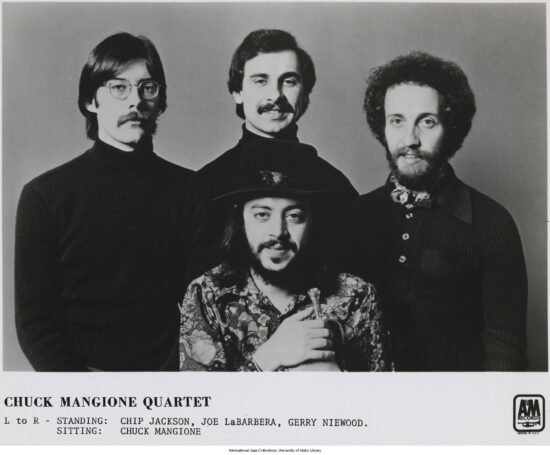Jazz trumpeter, flugelhorn player and composer Chuck Mangione — the man behind the pop-jazz instrumental crossover Top 10 hit “Feels So Good,” and an animated version of himself on Mike Judge’s King of the Hill cartoon series — died on July 22, at the age of 84.
The Rochester, New York native’s death was first reported by that city’s WROC-TV with the news that Mangione passed away in his sleep.
Though Mangione played the sweetest of trumpet and flugelhorn throughout the 1960s for drummer Art Blakey and the Jazz Messengers — as well as the brass man’s own Mangione Brothers Quintet and Sextet (“Something Different,” by the latter, was recorded by Cannonball Adderley for his 1961 album African Waltz) — it wasn’t until 1978 that sound of his flugelhorn and the soothing sway of his compositional largesse made its greatest impact with the release of his 1977 album Feels So Good and its breakthrough title track.
A pleasant, midtempo melody that built to a percolating disco pulse by its finale, the track was highlighted by the lean, clarion call of Mangione’s flugelhorn and the tickling tone of his electric piano. It was a signature MOR sound that reached No. 4 on Billboard’s Top 10 singles and Adult Contemporary Chart and the album to No. 2 on the Billboard year-end albums chart of 1978 (behind the Bee Gees’ Saturday Night Fever soundtrack). Equally iconic: the shaggy dog cover of Feels So Good with a long-haired Mangione hugging his instrument while wearing an early model bucket hat and a huge grin.
That look, tracksuit and all, became part and parcel of the animated Mangione that appeared, voiced by himself, on the blue-collar comic showcase King of the Hill from 1997 to 2009. Along with Mangione as a celebrity pitchman for the fictional Arlen, Texas town’s Mega Lo Mart, his “Feels So Good” was in constant use throughout the animated series. “My character would do things like play ‘Taps’ and switch right into ‘Feels So Good,’” Mangione once told the Celebrity Café. “I figured that since they were playing my music and to such a large audience, why not?”
Mangione was born on November 29, 1940, raised in the Rochester, New York area by Italian immigrant jazz aficionado parents. By the age of eight he started formal music lessons, first on piano, eventually switching to cornet after seeing Young Man with a Horn, the 1950 Kirk Douglas film inspired by the life of cornetist Bix Beiderbecke.
After forming his first jazz band in high school with his pianist brother, Gap, Mangione attended the Eastman School of Music from 1958 to 1963 (he later returned to Eastman as a teacher and the director of its Eastman Jazz Ensemble). Before graduation, however, Mangione had already been a part of Art Blakey’s Jazz Messengers at the same time as the young Keith Jarrett; written songs taken up by Cannonball Adderly, and recorded The Jazz Brothers as “The Mangione Brothers Sextet with Chuck Mangione” for the Riverside label in 1961, along with its immediate follow-ups that same year, Hey Baby! and Spring Fever.
Mangione’s springy electric jazz vibing solo career took off — as did his bucket hat look — with the 1970 double album Friends & Love… A Chuck Mangione Concert. The first release for his Mercury label deal was recorded at the Eastman Theatre in Rochester, featured the poppy “Hill Where the Lord Hides” single. It co-starred the Rochester Philharmonic Orchestra conducted by Mangione, along with his brother Gap Mangione and drummer Steve Gadd.
While the 1971 Mercury album Together: A New Chuck Mangione Concert was also recorded live in Rochester, the 1973 outing Land of Make Believe used superstar trumpeter Jon Faddis and vocalist Esther Satterfield in the first of several appearances on Mangione albums.
 The year 1975 found Mangione moving to fellow instrumental music icon Herb Alpert’s A&M label — a nearly decade-long affiliation — with Chase the Clouds Away, a cool breezy album whose ecstatic title track was used as a theme song of sorts throughout the 1976 Montreal Summer Olympics. Mangione followed this up with Feels So Gool, then 1978’s windswept Children of Sanchez album, a soundtrack to the film of the same name, which won a Grammy for Best Pop Instrumental Performance for the title song (Mangione actually won his first Grammy for his 1976 effort Bellavia).
The year 1975 found Mangione moving to fellow instrumental music icon Herb Alpert’s A&M label — a nearly decade-long affiliation — with Chase the Clouds Away, a cool breezy album whose ecstatic title track was used as a theme song of sorts throughout the 1976 Montreal Summer Olympics. Mangione followed this up with Feels So Gool, then 1978’s windswept Children of Sanchez album, a soundtrack to the film of the same name, which won a Grammy for Best Pop Instrumental Performance for the title song (Mangione actually won his first Grammy for his 1976 effort Bellavia).
By the early 1980s, Mangione changed his label affiliation from A&M to Columbia for a five-album run, starting with Love Notes and concluding with Eyes of the Veiled Temptress in 1988. He then formed his own Feels So Good label imprint in the late 1980s for releases such as The Boys from Rochester, The Hat’s Back (1994) and his reunion album Together Forever with Steve Gadd (also ’94). JT
